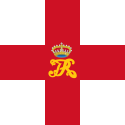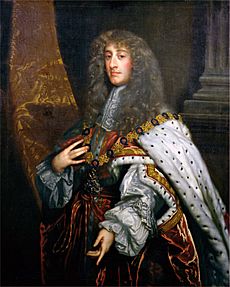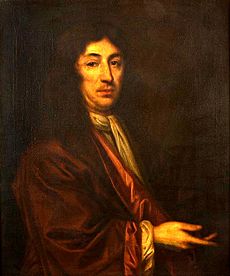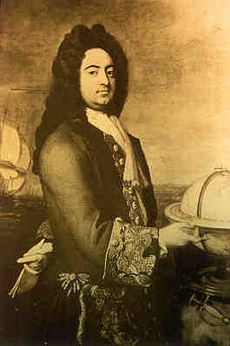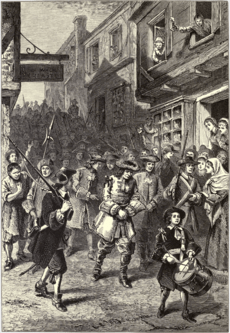Dominion of New England facts for kids
Quick facts for kids
Dominion of New England
|
|||||||||||||||||||||
|---|---|---|---|---|---|---|---|---|---|---|---|---|---|---|---|---|---|---|---|---|---|
| 1686–1689 | |||||||||||||||||||||
|
|
|||||||||||||||||||||
|
Motto: Nunquam libertas gratior extat (Latin)
Nowhere does liberty appear in a greater form (English) |
|||||||||||||||||||||

Map of the Dominion, represented in dark red, as of 1688. Names of the constituent and neighboring colonies also shown.
|
|||||||||||||||||||||
| Status | Disestablished | ||||||||||||||||||||
| Capital | Boston | ||||||||||||||||||||
| Common languages | English, Dutch, French, Iroquoian, Algonquian | ||||||||||||||||||||
| Government | Direct rule colonial government | ||||||||||||||||||||
| Monarch | |||||||||||||||||||||
|
• 1686–1688
|
James II | ||||||||||||||||||||
|
• 1688–1689
|
William III & Mary II | ||||||||||||||||||||
| Royal Governor | |||||||||||||||||||||
|
• 1686
|
Joseph Dudley | ||||||||||||||||||||
|
• 1686–1689
|
Edmund Andros | ||||||||||||||||||||
| Lieutenant Governor | |||||||||||||||||||||
|
• 1688–1689
|
Francis Nicholson | ||||||||||||||||||||
| Legislature | Council of New England | ||||||||||||||||||||
| Historical era | British colonization of the Americas Glorious Revolution Colonial History of the United States |
||||||||||||||||||||
|
• Established
|
1686 | ||||||||||||||||||||
| April 18, 1689 | |||||||||||||||||||||
| May 31, 1689 | |||||||||||||||||||||
|
• Disestablished
|
1689 | ||||||||||||||||||||
| Currency | Pound sterling | ||||||||||||||||||||
|
|||||||||||||||||||||
| Today part of | United States | ||||||||||||||||||||
The Dominion of New England was a large group of English colonies in America. It existed from 1686 to 1689. This union included colonies in New England and the Mid-Atlantic region. It was set up by the English king to have more control. The colonists did not like it because they felt their rights were taken away. Their special agreements, called charters, were also cancelled. Governor Sir Edmund Andros was in charge. He tried to make many changes. But the colonists rebelled when they heard that King James II was no longer king in England. Most of Andros's changes were then undone.
The Dominion covered a huge area. It stretched from the Delaware River in the south to Penobscot Bay in the north. It included New Hampshire, Massachusetts Bay Colony, Plymouth Colony, Rhode Island, Connecticut Colony, New York, and New Jersey. This area was too big for one governor to manage well. Governor Andros was very unpopular. Many people saw him as a threat to their way of life. When news of the Glorious Revolution in England reached Boston in 1689, the colonists rebelled. They arrested Andros and his officers in what became known as the 1689 Boston revolt.
Another rebellion, called Leisler's Rebellion, happened in New York. It removed the Dominion's lieutenant governor, Francis Nicholson. After these events, the colonies went back to their old forms of government. Some governed without a formal charter for a while. Eventually, King William III of England and Queen Mary II gave them new charters.
Contents
Why Was the Dominion Created?
Many English colonies were started in North America in the 1600s. Some were for business, like Virginia Colony. Others were for religious freedom, like Plymouth Colony and Massachusetts Bay Colony. Their governments were also different. Virginia became a royal colony, directly controlled by the king. Massachusetts and other New England colonies had charters. These gave them a lot of freedom to govern themselves.
After 1660, King Charles II wanted to manage his colonies better. He and his government started taking more direct control. One reason was the cost of running each colony separately. Another big reason was to control trade.
Trade Rules and Resistance
In the 1660s, England passed laws called the Navigation Acts. These laws controlled how the colonies traded. American colonists did not like these laws, especially in New England. New England had strong trade networks with other English colonies and European countries. The Navigation Acts made some of their trade illegal. This turned many merchants into smugglers. It also made business much more expensive.
Some New England colonies caused specific problems for the king. Combining them into one big area seemed like a solution. For example, Plymouth Colony never had a formal charter. The New Haven Colony had protected people who had helped execute King Charles I. The land in Maine was also disputed. New Hampshire was a small, new royal colony.
Massachusetts was a big problem for the king. It had a long history of being ruled by religious leaders. They also strongly resisted the Navigation Acts. They did not like non-Puritans, including supporters of the Church of England. King Charles II tried many times to change the Massachusetts government. But they refused to make any real changes. In 1684, their charter was officially cancelled.
England's main goal was to make the colonies richer for England. The king wanted the colonies to produce raw materials like tobacco or rice. This worked well for the southern colonies. But New England's land was not good for these crops. So, New Englanders focused on trade. They became very good at it, which worried English merchants. They also started making their own goods, like textiles and ironware. This threatened England's market for manufactured items. The plan was to create one strong government over the northern colonies. This would stop them from manufacturing and trading with other countries.
Starting the Dominion
After Massachusetts' charter was cancelled, King Charles II and the Lords of Trade moved forward. They planned to create one government for some New England colonies. The Dominion's goals included controlling trade and changing land ownership rules. They also wanted to improve defense and make government simpler.
The Dominion first included Massachusetts Bay Colony, Plymouth Colony, New Hampshire, Maine, and Narraganset Country (now Washington County, Rhode Island).
King Charles II chose Colonel Percy Kirke to govern the Dominion. But Charles died before Kirke's appointment was approved. King James II approved Kirke in 1685. But Kirke was criticized for his harsh actions in a rebellion. So, his appointment was cancelled.
Instead, Joseph Dudley was chosen as the temporary President of the Council of New England. This was because there were delays in appointing Sir Edmund Andros, who was meant to be the main governor. Dudley's job started on October 8, 1685.
Dudley's Time in Charge
Dudley's official papers arrived in Boston on May 14, 1686. He took charge of Massachusetts on May 25. His rule did not start well. Many Massachusetts leaders refused to join his council. According to Edward Randolph, a crown agent, the Puritan leaders believed "God would never suffer me to land again in this country." They acted as if they had more power than ever before. Many colonial military officers also refused to serve.
Dudley had trouble raising money for the Dominion. His orders did not allow new tax laws. Massachusetts had cancelled all its tax laws in 1683. Many people also refused to pay old taxes. They argued that these taxes were from the old government and were no longer valid. Dudley and Randolph tried to bring the Church of England to Massachusetts. But they lacked money and faced strong opposition from existing churches.
Dudley and Randolph did enforce the Navigation Acts. But they sometimes overlooked small violations. They knew some parts of the laws were unfair. They suggested changing the laws to the Lords of Trade. However, the Massachusetts economy suffered. It was also affected by other problems. Dudley and Randolph later had a disagreement about trade.
During Dudley's time, the Lords of Trade decided to add Rhode Island and Connecticut to the Dominion. This happened on September 9, 1686. Andros's main appointment had been issued in June. He was given an extra order to include these colonies.
Andros's Rule
Andros had been governor of New York before. He arrived in Boston on December 20, 1686, and immediately took power. He was very strict. He claimed that colonists lost their rights as Englishmen when they left England. The Reverend John Wise gathered his church members in 1687 to protest taxes. Andros had him arrested, found guilty, and fined. An official told Wise, "Mr. Wise, you have no more privileges Left you then not to be Sold for Slaves."
Andros's orders said he would rule with a council. The first council had members from each colony in the Dominion. But most council meetings were attended by people from Massachusetts and Plymouth. This was because travel was difficult and expensive for others.
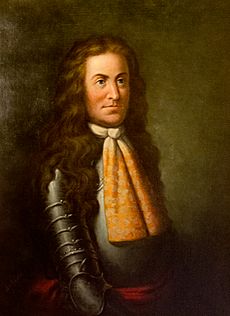
Church of England Services
Soon after arriving, Andros asked Puritan churches in Boston if the Church of England could use their buildings. They always said no. In 1687, he demanded the keys to Samuel Willard's Third Church. Church of England services were held there until 1688. That's when King's Chapel was built.
New Tax Laws
After Andros arrived, the council started changing laws. They wanted all laws in the Dominion to be like English laws. This took a long time. So, in March 1687, Andros announced that old laws would stay until new ones were ready. Massachusetts had no old tax laws. So, a new tax plan was created for the whole Dominion. It was based on import duties. After much debate, a different plan was quickly adopted. This plan brought back old Massachusetts tax laws. These laws were unpopular with farmers because they taxed livestock heavily.
Many Massachusetts towns strongly resisted the new tax laws. Several towns refused to choose people to assess their populations and properties. Officials from these towns were arrested and brought to Boston. Some were fined and released. Others were jailed until they agreed to do their jobs. The leaders of Ipswich were the loudest in their opposition. They were tried and found guilty of minor crimes.
Other provinces did not resist the new law. Even though the taxes were higher than before in Rhode Island, they accepted them. Plymouth's poorer landowners were hit hard by the high taxes on livestock.
Town Meetings Restricted
Because of the tax protests, Andros tried to limit town meetings. These meetings were where the protests started. He made a law that allowed only one town meeting per year. This meeting was only for electing officials. It specifically banned meetings at other times for any reason. This loss of local power was widely hated. Many people protested that these laws violated the Magna Carta. The Magna Carta guaranteed that people would be taxed by their own representatives.
Land Titles and Taxes
Andros caused a big problem for the colonists by questioning their land ownership. Unlike England, most Americans owned land. Historians say that colonists saw land ownership as key to their freedom and wealth. So, they were shocked by the widespread and expensive challenge to their land titles. Andros was told to make colonial land rules more like England's. He also had to introduce "quit-rents" to raise money for the colony.
Many land titles in Massachusetts, New Hampshire, and Maine had problems. For example, they might not have the colonial seal. Most also did not include a quit-rent payment. Land grants in Connecticut and Rhode Island were made before these colonies had charters. There were also conflicting claims in some areas.
Andros's approach made things worse. It threatened any landowner whose title was unclear. Some landowners went through the process to confirm their titles. But many refused. They did not want to risk losing their land. They saw the process as a way for the government to take their land. The Puritans of Plymouth and Massachusetts Bay were among those who refused. Many of them owned a lot of land. All existing land titles in Massachusetts were granted under the old, now-cancelled charter. Andros basically said these titles were invalid. He demanded that landowners re-certify their ownership. This meant paying fees to the Dominion and then paying a quit-rent every year.
Andros tried to force people to certify their ownership. He issued special orders called writs of intrusion. But large landowners who owned many pieces of land fought these orders one by one. They did not re-certify all their lands. Few new land titles were issued during Andros's rule. Out of 200 applications, only about 20 were approved.
Connecticut's Charter
Andros's orders included Connecticut. He asked Connecticut Governor Robert Treat to give up the colony's charter soon after arriving in Boston. Connecticut officials formally accepted Andros's authority. This was different from Rhode Island, which accepted the Dominion but did little to help him. Connecticut continued to run its government using its charter. They held legislative meetings and elected officials. Treat and Andros talked about giving up the charter.
In October 1687, Andros decided to go to Connecticut himself. He arrived in Hartford on October 31 with an honor guard. He met with the colonial leaders that evening. A famous story says the charter was on the table during this meeting. The lights in the room suddenly went out. When they were relit, the charter was gone. It was said to have been hidden in a nearby oak tree, later called the Charter Oak. This way, no one could find it by searching nearby buildings.
Whether the story is true or not, Connecticut records show that its government officially gave up its seals and stopped operating that day. Andros then traveled around the colony. He made judicial and other appointments. Then he returned to Boston. On December 29, 1687, the Dominion council officially extended its laws over Connecticut. This completed the joining of the New England colonies.
Adding New York and the Jerseys
On May 7, 1688, New York, East Jersey, and West Jersey were added to the Dominion. These areas were far from Boston, where Andros lived. So, New York and the Jerseys were managed by Lieutenant Governor Francis Nicholson from New York City. Nicholson was an army captain. He came to Boston in early 1687 as part of Andros's honor guard. He had been promoted to his council.
In the summer of 1688, Andros traveled to New York and then to the Jerseys. He went to set up his authority there. Governing the Jerseys was tricky. The owners' charters had been cancelled. But they still owned their land. They asked Andros for traditional land rights. The Dominion period in the Jerseys was fairly quiet. This was because they were far from the main power centers. Also, the Dominion ended unexpectedly in 1689.
Dealing with Native Americans
In 1687, the governor of New France, Denonville, attacked Seneca villages. These were in what is now western New York. He wanted to stop trade between the English at Albany and the Iroquois confederation. The Seneca were part of the Iroquois. He also wanted to break the Covenant Chain, a peace agreement Andros had made in 1677.
New York Governor Thomas Dongan asked for help. King James ordered Andros to assist. James also started talks with the French king. This helped ease tensions on the border.
However, on New England's northeastern border, the Abenaki people had complaints against English settlers. They began attacking in early 1688. Andros led an expedition into Maine early that year. He raided several Native American settlements. He also raided the trading post of Jean-Vincent d'Abbadie de Saint-Castin on Penobscot Bay. Andros carefully protected Castin's Catholic chapel. This later led to accusations that Andros supported "popery" (Catholicism).
Andros took over New York's administration in August 1688. He met with the Iroquois at Albany to renew their agreement. In this meeting, he upset the Iroquois. He called them "children," meaning they were under English control. They preferred to be called "brethren," meaning equals.
Andros returned to Boston. More attacks on the New England border by Abenaki groups were happening. The Abenaki said they were doing this partly because the French encouraged them. The situation in Maine had also gotten worse. English colonists were raiding Native American villages and sending captives to Boston. Andros criticized the Maine settlers for this. He ordered the Native Americans released and returned to Maine. This made the Maine settlers hate him. He then returned to Maine with a large force. He began building more forts to protect the settlers. Andros spent the winter in Maine. He returned to Boston in March after hearing rumors of a revolution in England and unhappiness in Boston.
End of the Dominion
The religious leaders of Massachusetts, like Cotton and Increase Mather, did not like Andros's rule. They worked to influence the court in London. After King James issued the Declaration of Indulgence in May 1687, Increase Mather sent a letter to the king thanking him. He suggested other pastors also thank the king to gain favor. Ten pastors agreed. They decided to send Mather to England to argue against Andros. Edward Randolph tried to stop him. Mather was arrested, tried, and found innocent on one charge. But Randolph issued a second arrest warrant with new charges. Mather secretly boarded a ship for England in April 1688.
Mather and other Massachusetts agents were well received by King James. In October 1688, James promised to address the colony's concerns. However, the Glorious Revolution happened. By December, James had been removed from power by William III and Mary II.
The Massachusetts agents then asked the new monarchs and the Lords of Trade to bring back the old Massachusetts charter. Mather also convinced the Lords of Trade to delay telling Andros about the revolution. He had already sent a letter to former colonial governor Simon Bradstreet. The letter said that a report (made before the revolution) stated the charter was illegally cancelled. It also said that leaders should "prepare the minds of the people for a change."
News of the revolution reached some people as early as late March. Bradstreet may have been one of the organizers of the crowd that formed in Boston on April 18, 1689. That day, he and other former leaders wrote an open letter to Andros. They asked him to surrender to calm the crowd. Andros, Randolph, Dudley, and other Dominion supporters were arrested and imprisoned in Boston.
The Dominion then fell apart. Local leaders in each colony arrested Dominion officials. They took back their old powers. In Plymouth, Dominion councilor Nathaniel Clark was arrested on April 22. Former governor Thomas Hinckley was put back in charge. Rhode Island leaders organized elections on May 1 to restart their charter government. But former governor Walter Clarke refused to serve. So, the colony continued without a governor. In Connecticut, the old government was also quickly restarted. New Hampshire was left without a formal government for a time. It was unofficially ruled by Massachusetts Governor Simon Bradstreet.
News of the Boston revolt reached New York by April 26. But Lieutenant Governor Nicholson did not act immediately. Andros managed to send a message to Nicholson from prison. Nicholson got the request for help in mid-May. But he could not do anything. Tensions were rising in New York. Also, most of Nicholson's troops had been sent to Maine. At the end of May, Nicholson was overthrown by local colonists and the militia in Leisler's Rebellion. He fled to England. Leisler governed New York until 1691. That's when King William appointed Colonel Henry Sloughter as governor. Sloughter had Leisler tried for treason. He was found guilty in a trial led by Joseph Dudley and then executed.
Massachusetts and Plymouth After the Dominion
The end of the Dominion created legal problems for Massachusetts and Plymouth. Plymouth never had a royal charter. Massachusetts' charter had been cancelled. So, the restored governments had no legal basis. Their political opponents often pointed this out.
This was especially a problem in Massachusetts. Its long border with New France was left unprotected. Its defenders were called back after the revolt. The colony was then open to French and Native American raids after King William's War started in 1689. Defending the colony was very expensive. The war also made it hard to rebuild the colony's trade.
Agents for both colonies worked in England to fix the charter problems. Increase Mather asked the Lords of Trade to bring back the old Massachusetts charter. King William was told that this would bring back the Puritan government. He wanted to prevent that. So, the Lords of Trade decided to combine the two colonies. The new Province of Massachusetts Bay included Massachusetts and Plymouth. It also included Martha's Vineyard, Nantucket, and the Elizabeth Islands. These had been part of Dukes County in New York.
Images for kids
See also
 In Spanish: Dominio de Nueva Inglaterra para niños
In Spanish: Dominio de Nueva Inglaterra para niños


